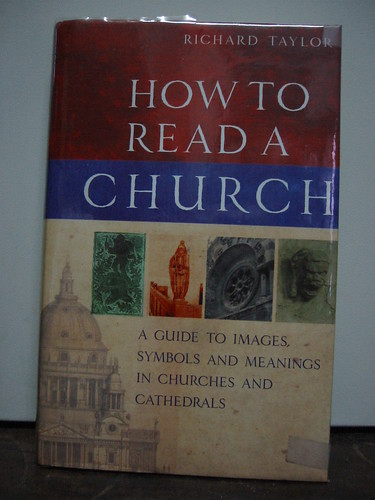Read any churches lately?

If you were born and raised a Catholic you often take things for granted. Every Sunday you go to mass. Baptismal, communion, confirmation, marriage, and last rites are things that eventually happen. The building where this happens is there it seems for perpetuity, well at least that is what it seems. And if you live in the Philippines churches seem to be everywhere.
Perhaps that is why the Spanish Colonial period is sometimes described as "Bajo delas Campanas" or under the church bells. Three hundred years of Spanish colonisation would not have been succesful without the church. The sword and the cross effectively governed the country.
Departing from a little bit of history, we know that churches are ubiquitous, at least in the Philippines. The old walled city had more than five churches inside its walls. And during lent some of us make it a point to visit at least 7 or more churches during Visita Iglesia. But are we really familiar with our church? Have we taken time to take a closer look at our church?
I have come across a book that will shed some light into this dilemma.
Close to a year ago, I got this book from the previously owned books section of the National Book Store. What I have learned and wrote often is that previously owned at NBS means second handbooks and books owned by other bookstores. So I often find it useful to visit the topmost floor of the NBS superstore, who knows what you can find.
Now, what is fascinating about this book?
Churches and Cathedrals were built not only for worship but to be read. What are obvious to most of us, well at least for me, are the stained glass windows and the statues scattered throughout the church. A closer look at the architecture, layout, seemingly randomly placed symbols and even colours inside the church will reveal deeper meanings. The church was more than a house to celebrate mass or for the faithful to congregate. It was a testimony to the faith.
It is an interesting read. The book begins with preliminaries, the author being an Anglican, takes the time to explain the intricacies and differences between the different Christian Religions and churches. Taylor then proceeds to explain the significance of the architecture, the layout, the different crosses, even the furniture and other elements inside the church. He also provides a small chapter on how to read a priest.
What is interesting about Taylor's book is that it provides a guidebook for us. So the church becomes a book of sorts that reveals its secret to us like a rose shedding its petals.
Mr Taylor's profession is the law, which he took up at Oxford and the London University. His interests though have provided him with a unique pastime, Christian symbolism. It would seem that his interest in this area of study has been so succesful that he has become a lecturer on the topic, to people from several faith and no faith. If we are to believe his short biography at the dustcover of the book. After reading the book, I think I believe his biography is true, for only a person with genuine interest in this topic can write it an engaging and informative manner.
Aside from an interesting read and a good reference source, the book enables the reader to appreciate the church, regardless of one's faith or lack of it.
BTW, Did you know there are five types of halos and they have different meanings. I found that out in the book. Even they lay-out of the church served a particular purpose. Or that Judases symbol is the rope ( you probably knew that) but do you know which disciple has a boat as symbol? Or what does the salamander or the pelican symbolize? An interesting read indeed.
Taylor, Richard. HOW TO READ A CHURCH: A Guide to Images, Symbols and Meanings in Churches and Cathedral.Rider, Random House. London. UK. Copyright 2003.


4 Comments:
Looks like an interesting book. Alas might be out of stock.
Do not give up hope. The book was not written in a monk's scriptorium there maybe copies floating around. :)
How lucky of you to find such a treasure. I try to rummage among pre-owned books that are sold in bookstores here but have not found any to my liking.
Also, I didn't think that a church would be that interesting. Then I must put Bohol in my list of future destinations.
Bugsybee,
Its all luck. Last December's stash was a windfall. Imagine all books from WHSmith, I think they had some financial problems so they got rid of their stock. It still worthwhile to check the top floor of the NBS superstore at Cubao.
The Miag-ao Church at Miag-ao, Iloilo is also worht a visit, if you ever find yourself in Iloilo.
:)
Post a Comment
<< Home